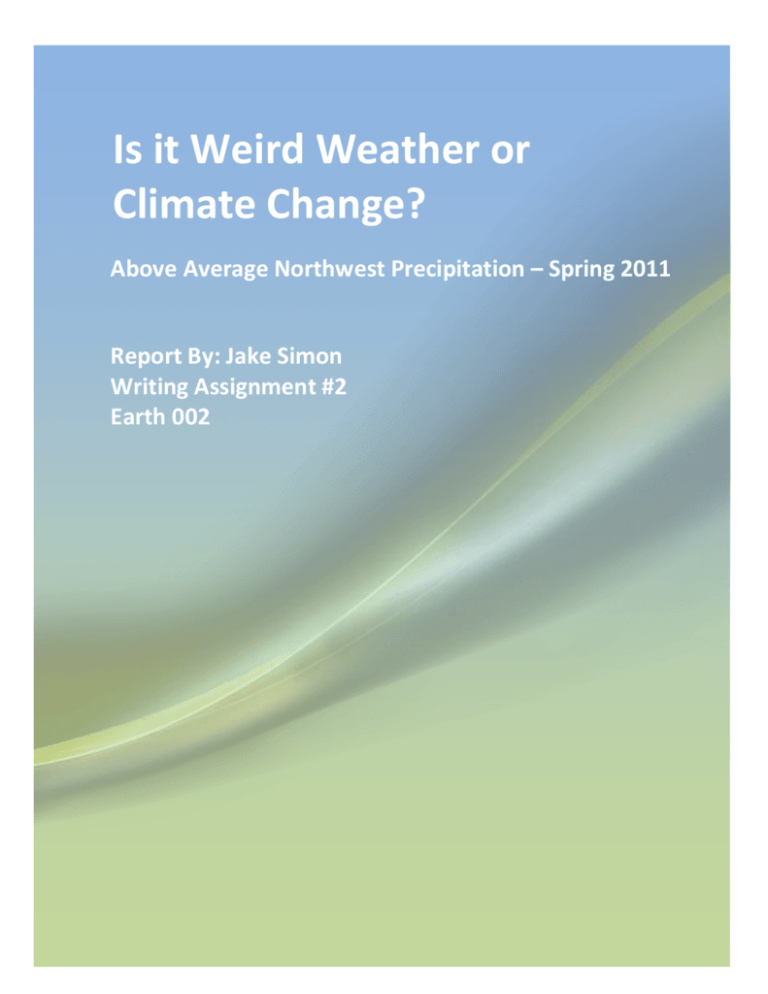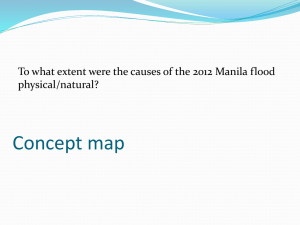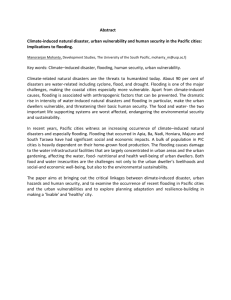File - Jake E. Simon
advertisement

Is it Weird Weather or Climate Change? Above Average Northwest Precipitation – Spring 2011 Report By: Jake Simon Writing Assignment #2 Earth 002 Jake Simon Earth 002 – Section 1 Assignment 2- Is It Weird Weather of Climate Change Spring 2011 Precipitation values in the Northwest March 26th, 2012 I. Introduction The spring (March—May) of 2011, in specific, April, brought extreme weather and climate events to many parts of the United States. Drought, wildfires, tornadoes and flooding shattered a lot of parts of the country during this time period. Much of these events have been compared to the ‘worst possible cases’ in history. Specifically, in the Northwest region of the United States, record rainfall along both the Mississippi River, Missouri and Ohio River Valley caused record flooding along both rivers, with water levels surpassing the historic floods of both 1927 and 1937. Above average snowpack, combined with warm spring temperatures an above average precipitation caused record flooding across the northern plains and specifically the Upper Northwest in the late spring of 2011. In the past decade, the flooding of both the Mississippi River, Missouri and Ohio River Valley were among the largest and most damaging recorded. According to CNN, “Areas along the Mississippi experienced flooding included Illinois, Missouri, Kentucky, Tennessee, Arkansas, Mississippi, and Louisiana. U.S. President Barack Obama declared the western counties of Kentucky, Tennessee, and Mississippi federal disaster areas.” Heavy rains caused widespread flooding across the Northwest region and this weather event had many consequences for society. The territory affected left residents stranded and business closed for days. Left with no electricity or telephone service, the flooding of hundreds of thousands of acres caused devastation to more than ten states within the Northwest region. II. Hypothesis I hypothesize that the record rainfall in the spring of 2011 that caused above-average flooding in the Northwest region was within natural variation. Although I do not believe that this anomalous weather event indicates climate change, I theorize that this was weird weather that can be explained by natural variability. I also do believe that the range of variability is in fact changing over time. III. Evaluation of Hypothesis I believe that within the past century there is no reason to consider the above average precipitation in the Northwest region of the United States as a sign of climate change. The included graphs and tables that follow show how that although there was an increased amount of precipitation, that it can be caused by a slight increase in natural variation. As seen in the following graphs, there is an obvious variability in the amount of precipitation for the Northwest region during the months of spring, but not enough to conclude climate change. Defined as the ‘weather over long periods,’ climate often gets confused with weird weather. Just because there is one or multiple weather anomalies doesn’t mean the weather is changing over a longer period of time, which is evident in the fist chart. The above chart shows the precipitation values for the Northwest region of the United States for the spring (March—June). The values are compared for each year since the beginning of 1900. Although the red trend line shows an obvious slight increase in precipitation amounts over the years, the amount is not enough to be considered a change in climate. As I said before, climate is more the change over hundreds of hundreds of years, not a few centuries. This chart shows how over the past century there has been an increase of 1.29 inches. There is still only on average, 8inches of rain for the northwest region this past year. This chart definitely shows variability in the weather for this particular area and how there is a long-term trend of a slight increase of precipitation. In light of this evidence I found, I feel as though my hypothesis correlates perfectly with this data. As seen in the past decade, there has been a spike in the average precipitation amounts, but not more than there has been in the past. As seen from the chart, around 1990 there was a spike of an average of 12 inches of precipitation for this region! Similarly, the increase and decrease of precipitation amounts clearly indicate how the amounts are always changing and thus, cannot be a result of climate change. The following chart is provided by NOAA’s Climate At A Glance, which shows the Spring 2011 precipitation amounts for the entire United States. This is a good chart to show how many states had precipitation values that were near normal, above normal, much above normal and record amounts. As seen in the above chart, out of these 48 states, more than half of them had above normal precipitation amounts. Within the 3 months of March—May of 2011, 10 states had record amounts of precipitation. Although this graph shows how there was an obvious increase in the amount of precipitation for this time, it does not prove that it is because of climate change. This graph rather shows how this is more of a peak in the natural variability of the weather of this region. Below you will see a map provided by NOAA of flooding areas on June 18th 2011. The purple and orange dots reflect heavy and moderate flooding. The flooding was triggered by record snowfall in the northwestern region, specifically in the Rocky Mountains of Montana and Wyoming. There are six major damns along the Missouri River that released record amounts of water to prevent an overflow. This graph clearly shows the heavy amounts of precipitation in the region, but only specifically for June 18th. Like I said earlier, climate change cannot be determined from one weather anomaly, rather a series of anomalies that are combined. Despite the obvious increase in precipitation, this is strictly due to natural variability of the weather within the Northwest region. IV. Societal Relevance Simply, flooding causes devastation. No matter what causes or affects the flood, in the end, there is a ton of damage. Specifically with the flooding in the Northwest region of the United States during the spring of 2011, the damage left caused economic problems that are still present now for the region. If my hypothesis is in fact correct, a possible implication for society would be more and more flooding within the continental United States. Extensive planning would need to be done in order to mitigate financial costs associated with the weather in light of natural variability. As of right now, the United States has possible plans for heavy flooding within the Northwest region, such as intentionally flooding smaller areas in order to save larger ones. These plans will be in effect if the flooding becomes more common, but new solutions need to be implemented in the future to save the economy and land. The impacts of the 2011 flooding are far reaching. They affect economic sectors such as agriculture, shipping, fishing, insurance and tourism. This was all because of the thousands of acres of farmland that were flooding. In prime growing season, this affected the massive amounts of products that were now worthless. It was reported that “nearly 900,000 acres of farmland in Mississippi was flooded—roughly 10 percent of all farmland in the state.” All this damage adds up and costs both the United States as well as separate states well over hundreds of millions of dollars to repair. In specific, the flowed into the Gulf of Mexico, which thus wiped out the oyster beds, which ‘need salt water to keep their metabolisms in check.’ The large amounts of fresh water in the Gulf made the area a ‘dead-zone’ of oysters, which affected the economy as well as ecosystem. This shows the affect this weather anomaly had on society and how relevant is it, because it affects everyone. Below is a chart with estimated costs that were caused by the increased amount of precipitation in the Northwest region is the spring of 2011. $23 million $25 million $305 million $92 million $64 million Flood Fight efforts (National Guard) Federal agencies cost (Corps of Engineers) Infrastructure costs (schools, streets, water systems, etc.) Paid out to individuals (direct federal costs) Prevent damages in the future Although these figures are just averages, if anything, the estimates are too low. In total, roughly $500 million dollars was spent to help aid and prevent further flooding in this area. This truly shows how the flooding affects everyone. Whether a person directly affected by the flood or a taxpayer, everyone is involved in the aftermath of the flooding. V. Conclusion Based on the previously observed data and reasoning to prove my hypothesis right, I stand by my original belief that the increased amount of precipitation in the Northwest region this past spring was due to natural variation. It is evident from each graph, chart and figure that spring of 2011 had above average precipitation values, but not that can be proven by climate change. It is still too early to be able to give an exact figure for the damages done and economic loss for the flooding in the spring of 2011. However, it is evident from the previous facts and figures that the flooding that occurred across the Northwest region of the United States during the spring of 2011 will be one of the worst flooding disasters in modern American history. It is also evident that the increased precipitation amounts were due to the natural variability of the weather for this region. VI. Citations http://thinkprogress.org/romm/2011/06/14/245431/us-hadmost-extreme-spring-on-record-for-precipitation/?mobile=nc http://plainsdaily.com/entry/cost-of-2011-flood-estimated-at-509million/ http://www.ncdc.noaa.gov/temp-and-precip/timeseries/index.php?parameter=pcp&month=6&year=2011&filter=4&state= 108&div=0 http://climvis.ncdc.noaa.gov/cgi-bin/cag3/state-map-display.pl







